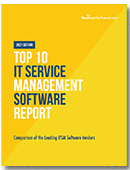IT Service Management
ITIL Course: Service Catalog 101

Welcome to the ITIL Class on Service Catalog. Over the course of this article, you will gain a better understanding of the function of a service catalog and the effort required to build one.
Service Catalog 101 – Lesson 1
I like to start all ITIL courses with the basic overview, in this case from Wikipedia.
A service catalog (or catalog), as defined in Information Technology Infrastructure Library Service Design, is a list of services that an organization provides, often to its employees or customers. Each service within the catalog typically includes:
- A description of the service
- Timeframes or service level agreement for fulfilling the service
- Who is entitled to request/view the service
- Costs (if any)
- How to fulfill the service
The 2 views of a service catalog
There are 2 different views of a service catalog–the view from the end user and the view of the service catalog from the IT Organization. It is essential that the service catalog has a focus on the end user, not as an afterthought, but as the primary target.
The user point of view
When the end user visits the service catalog, they are seeking something specific; something needed to perform their role within the enterprise. It may be physical access to a building or computer access to servers and programs. They may be searching for employee benefit information; they may require marketing collateral for a trade show; they may need a reimbursement form or need to submit an incident request. The list of available services may be large enough to encompass everything that the employees would ever need or be as simple as a list of HR forms.
A comprehensive service catalog will be built from the entire enterprise; this is not just an IT exercise but includes Facilities, HR, IT, Finance, Procurement, Marketing and more. It is the role of the IT Organization to gather information and build consensus from the entire enterprise. This is your opportunity to drive enterprise-wide process improvements. Take the time to build a full spectrum of services – everything the users would ever need to do their jobs.
Service Catalog 101 – Lesson 2
Lesson 2 is about the steps to building a service catalog. There are many factors involved in building a complete service catalog, but as with every journey, it begins with the first step.
The first step
You must first obtain executive buy-in and support. It is then imperative to establish a service catalog team. This is not just a group from IT. Your service catalog needs to go beyond IT and the services that IT is even remotely involved in. The IT Organization may manage, from a technical point of view, the service catalog, but it is “owned” by the enterprise as a whole.
Now is the time to engage others throughout the enterprise. Although we all know that nothing ever gets done by committee, every department needs to provide input into the content of the Service Catalog. Again, the content requires input but not the technical development which can mainly be an IT project.
The service catalog, as it evolves, will eventually include every imaginable company-wide service that an employee (or other end user, for example, higher education students) will need to succeed. But for the initial implementation define the services to be added, and before you publish the service catalog to the entire enterprise, try a dry run.
If you have added specific services related to a department, say the HR on-boarding request, then have their team participate in the test. Although IT is a key stakeholder the process should be owned by HR.
A service catalog needs to start somewhere, so start sooner than later. The sooner you begin, then the sooner that you can begin to help the entire enterprise by improving service request fulfillment. As a starting point, make it simple, include the most widely used services from IT and the enterprise at large.
For the services that are beyond IT, start with the services where IT is involved. A great example would be working with facilities to build the physical building access process for the catalog.
Service Catalog 101 – Lesson 3
Are you ready to build your Service Catalog? If so, then it is time for the IT Organization to develop a comprehensive list of all services that are going to be offered to the end user. You need to consider everything that your target market, the end user, will need to do their jobs. Remember to be inclusive of other departments – HR, Facilities and beyond.
The content of a service listing
The service catalog is the point of contact between the end user and the IT Organization. As the key place that your customers access the delivery of IT Services, there are many elements of a service catalog. You must have: a basic description of all deliverables; their associated prices; the process owner contact; as well as, ordering and request process fulfillment.
Give the service a name and description
The term or name, by which the Service will be referred to by, is not just for the IT Organization, but most importantly, the end user. Although, the service items’ names may vary, always consider your customer. What would they type into a search to find a service? That is a good place to start the naming process.
Make the description easy to understand, simple and non-technical. Again, the service is not just for the IT staff, but for the entire enterprise. Write the service description at a high level, a few sentences or bullet points will do. Consider engaging others within the enterprise to assist with the description. You might consider working with the Communications team to help with the final customer facing name and associated description, maybe even the tags.
Determine the service availability or target availability
The service needs to contain details of your Service Level Agreement (SLA) – the availability of a service. Remember to make this as specific as possible including business hours and exceptions, for instance, holidays and weekends.
Consider what the IT Organization is trying to achieve with all business availability. What is the service’s target availability? What is the service criticality?
Who is the service owner?
If there is a cost associated with the service, which department (the IT organization or other department) or person within a department is responsible for paying for the service?
Communications and management of the service
Who is responsible for the communications between the customer and the person or department fulfilling the service request? Is the Service Desk Analyst the key contact? For large implementations, a Project Manager may be the key contact.
Determine the service criticality
The criticality of each service needs to be determined. The target availability will help to determine the SLA. Consider the criticality related to the enterprise as a whole. It may also be important to consider the business criticality, as well as, the operational expectations. Another important consideration includes prioritization, such as, VIP end user status.
Another area to begin with when choosing services, is to select ones that do not require the participation of a Service Desk Analyst. If you can find the services that can be completely automated, for example password resets, then the ROI on the implementation of your service catalog can build quickly.
Remember
Do not try to eat the entire apple, chew on one bite at a time. For the Phase I implementation, you can choose the most common services and those that can be managed within Tier 1 support. The most critical  services for the enterprise and other high priority services need to be built into the service catalog Phase I implementation too. Then begin to work towards the next Phase and the next. The service catalog is a living, breathing, growing, key element of a mature IT Organization.
services for the enterprise and other high priority services need to be built into the service catalog Phase I implementation too. Then begin to work towards the next Phase and the next. The service catalog is a living, breathing, growing, key element of a mature IT Organization.
To find out more about specific IT management solutions check out our collection of Top 10 IT Software reports.






